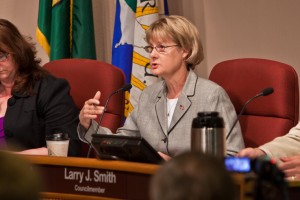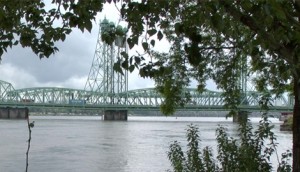Monday’s City Council workshop presented two hours of information on the Columbia River Crossing Light Rail Project. Twenty minutes in, Thayer Rorabaugh, Vancouver’s transportation policy director, asserted that light rail had already been approved. He noted that on July 7, 2008 the City Council endorsed a replacement bridge with a minimum of three thru lanes in each direction and after discussing two options for high capacity transit – bus rapid transit and light rail transit – the City Council chose light rail.

“The citizens have been duped into believing they would have a say if light rail proceeded,” says Jeanne Stewart.
Rorabaugh led the presentation with PowerPoint slides of the CRC project schedule, maps, and next steps. Council members, who also sit on those boards, will be asked to sign the federal environmental impact statement. Rorabaugh said he would return on July 18 for council action on the memorandum of agreement.
Presenters represented various levels of hands on experience with the CRC project*. Heather Gunderson, CRC environmental manager, has worked for the CRC since its inception six years ago. Nancy Boyd was recently appointed CRC director, and Rorabaugh retires from the city at the end of the year.
Acronyms ran unchecked through CRC dialogue of LPA conditions, DEIS, FEIS, RTC Council, NEPA process, BRT, LRT, and details of Section 106 MOA. Clearly, they sought to support the activity completed to date and emphasized the importance of working through the process to keep the CRC project on schedule – and according to Rorabaugh to “keep it moving.” Supporting members of the CRC sat in the audience and responded to council questions without using the podium.
Boyd noted that before taking the role as CRC director she needs to understand why the project was being done. She harkened back to the mission of the Department of Transportation and its responsibility for keeping goods and people moving, now and in the future.
“I am a willing participant,” she said.
Boyd noted problems of the corridor: An average of one crash a day in the project area – nearly double stats of comparable areas – as well as merging and weaving of vehicles, closely spaced interchanges, poor sight-lines, and congestion. She predicted that if conditions are left as they are now, collisions will increase 80 percent.
She identified the area as the most significant freight corridor on the West Coast, touting its importance to the community, the region, and the United States. The ability to have reliable passage through the corridor will narrow significantly as the population grows. “There’s $40 billion of freight that crosses the interstate bridge each year.”
On a smaller scale, the inadequate 4-foot width of the bike and pedestrian pathways are “difficult to navigate and very steep,” said Boyd. The current interstate bridges were built in 1917 and 1958, before modern understanding of seismic risk which “sets the stage for the environmental process.”
Heather Gunderson illuminated the council on the National Environmental Policy Act (NEPA), saying it is a procedural law but doesn’t “tell you how to get there. It’s not prescriptive. So project by project you sort of adapt.”
Adapting started in 2005 when the CRC’s work was about defining the transportation problems. In 2006/07 the CRC started developing alternatives to solve those problems, considering 23 different river crossing ideas, alternative corridors, supplemental bridges, arterial bridges, 14 transit ideas including monorail, people movers, and their potential affects. “In the NEPA process you’re allowed to evaluate things and dismiss them early in the process.” She said it was important to remember, “It’s part of the process to dismiss things as you go.”
In 2008, they drafted the Environmental Impact Statement. They selected the locally preferred alternative from thousands and moved into refining that alternative while comparing it to doing nothing. The final Environmental Impact Statement proceeded into the federal Record of Decision – a requirement to receive a chance at federal funding.
Gunderson announced this is the end of the environmental process, “But it’s not the end of the project. There are lots of conversations still to be had after the record of decision.” She explained that signing the record of decision acknowledges the NEPA process has been completed and the preferred alternative and mitigation described are eligible for federal funding. It does not commit the federal government to funding it. “The finance chapter of the FEIS doesn’t define how the project will be financed.”
Signing the FEIS also does not mean any entity has committed funds. It signifies agreement with the locally preferred alternative and agreement with the described analysis and impacts “as described currently.”
Gunderson’s most important slide noted the public has been involved and changes made from feedback. “There has been participation.”
Areas inside and outside the project scope were defined for the City Council, as well as displacements of businesses and residents, neighborhood impacts, water quality and noise abatement improvement, and economic barriers created by tolls for low income families. The disputed 21,000 jobs appeared onscreen and was defined as “Direct, indirect and induced jobs.”
Much praise was lavished on the Community Connector by both the panel and the council, which was described as a lid over I-5 connecting downtown and the historic reserve offering pedestrian and bicycle access, noise mitigation via a visual and cultural landscape.
A heated exchange between council member Jeanne E. Stewart and Mayor Timothy D. Leavitt erupted when Stewart voiced her continuing concerns about moving forward without allowing the public to vote on light rail.
“It doesn’t look to me as if the citizens are going to have a chance to vote on this in any meaningful way, and that light rail is just simply moving ahead.” Stewart said, and asked what would happen with the project if the citizens said they would not support the maintenance and operation of light rail.
“The citizens have been duped into believing they would have a say if light rail proceeded,” said Stewart.
Leavitt thanked her for the question and moved on.
* The well-documented cost to taxpayers, if the CRC stays on budget, is $10 billion. This was established by the Cortright Report (PDF) which used data from an independent review panel hired by the governors of Washington and Oregon. (View the panel’s final report.)
See our continuing coverage of the Columbia River Crossing Light Rail project.
Do you have information to share on the CRC? To respond anonymously call 260-816-1426. To allow your comments to be used on COUV.COM call 260-816-1429.











